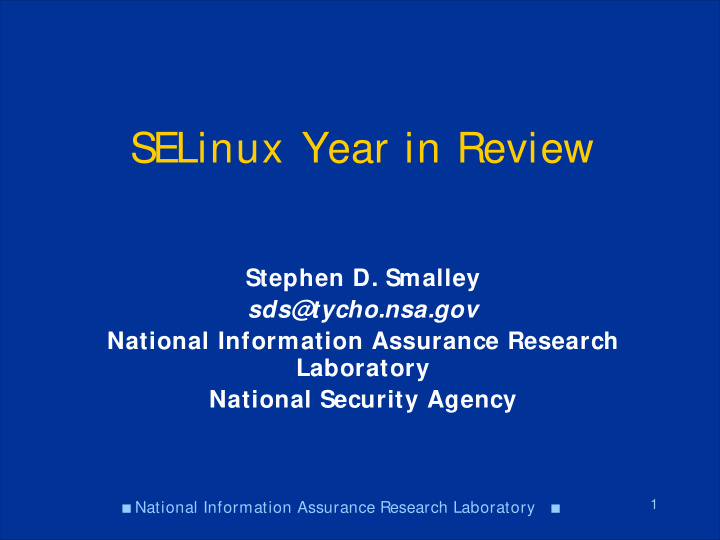



SELinux Year in Review Stephen D. Smalley sds@tycho.nsa.gov National Information Assurance Research Laboratory National Security Agency 1 National Information Assurance Research Laboratory ■ ■
Outline • SELinux Background • The Year in Review • What Lies Ahead 2 National Information Assurance Research Laboratory ■ ■
The Problem: Inadequate OS Security • OS protection mechanisms are foundational. • General purpose OSes lack adequate security mechanisms. – No protection against flawed or malicious applications. – Key missing feature: Mandatory Access Control (MAC) • “Trusted” OSes had a form of MAC but: – were not mainstream – used a fixed, limited MAC model (BLP/ Biba) 3 National Information Assurance Research Laboratory ■ ■
The Solution: Flexible MAC • Generalize MAC and make it flexible and configurable • Developed several research prototypes • Selected Linux for optimal technology transfer • Released reference implementation in December 2000 • Reworked approach for Linux Security Module framework • Integrated into mainline Linux 2.6 in August 2003 4 National Information Assurance Research Laboratory ■ ■
What SELinux Provides • Flexible MAC integrated into Linux. • Configurable policy engine supporting: – Type Enforcement (TE) – Role- Based Access Control (RBAC) – Optionally Multi- Level Security (MLS) • Ability to enforce confidentiality and integrity guarantees. • Ability to confine flawed and malicious applications. 5 National Information Assurance Research Laboratory ■ ■
Uses of SELinux • Enforce legal restrictions on data. • Prevent disclosure of sensitive data. • Prevent tampering with software and data. • Enforce critical processing on data. 6 National Information Assurance Research Laboratory ■ ■
Uses of SELinux • Restrict system services to authorized data. • Sandbox applications. • Prevent privilege escalation. – Contain damage from 0- day exploits. – Reduce need for immediate security patching of applications. 7 National Information Assurance Research Laboratory ■ ■
A Year Ago • SELinux included and enabled in Fedora Core 3 and Red Hat Enterprise Linux 4. – With several daemons locked down including Apache... • SELinux included as an option in Hardened Gentoo. – With strict policy, servers only. • SELinux available for other distributions. – Separate packages available for Debian unstable, SuSE. 8 National Information Assurance Research Laboratory ■ ■
Now • SELinux coverage significantly expanded in Fedora Core 4 (J une 2005) and 5 (soon). – Targeted policy has grown to ~120 confined domains. • SELinux updates in Hardened Gentoo. • SELinux support being mainstreamed into Debian. – Patches upstreamed into Debian unstable. – Separate back- port packages available for Debian stable. 9 National Information Assurance Research Laboratory ■ ■
A Year Ago • SELinux Multi- Level Security support was experimental and unused. • Auditing support was limited and not well integrated with SELinux. • No distribution with SELinux included had been evaluated. 10 National Information Assurance Research Laboratory ■ ■
Now • Multi- Level Security support enhanced and mainstreamed. • Audit system enhanced and increasingly integrated. • RHEL4 evaluated against CAPP (excludes SELinux). • RHEL5 entered into evaluation against CAPP, LSPP, and RBAC with SELinux coverage. 11 National Information Assurance Research Laboratory ■ ■
A Year Ago • Monolithic policy. – Source modules only, little encapsulation. • Limited, ad- hoc forms of policy customization. – Difficult to customize and still track vendor policy updates. • No programmatic interface for policy management. – Manipulation of text files, execution of policy build process. • Limited support for policy generation and development. 12 National Information Assurance Research Laboratory ■ ■
Now • Loadable policy modules – Build and package policy modules separately. • Reference policy – Explicit interfaces, strong encapsulation. • Policy management API (libsemanage) – Supports module operations and variety of local policy customizations. • Improved support for policy development. – Polgen, SEEdit, SLIDE, CDS Framework. 13 National Information Assurance Research Laboratory ■ ■
A Year Ago • No upstream solution for labeled networking. • Newly created files not labeled atomically. • File security labels only visible for some filesystems. • SMP scalability increasingly a problem. • Kernel memory use by policy increasingly a problem. 14 National Information Assurance Research Laboratory ■ ■
Now • IPSEC- based packet labeling upstream, scheduled for Linux 2.6.16. • Atomic labeling of new files. • File security labels visible for all filesystems exactly as seen by SELinux. • Major improvements in SMP scalability. • Significant reduction in kernel memory use by policy. 15 National Information Assurance Research Laboratory ■ ■
What Lies Ahead • Fine- grained access control over policy • Distributed policy management • Policy IDE and generation tools • Flexible networking controls • Network protected paths • Security- aware applications • Securing the desktop • Completion of the LSPP/ RBAC functionality 16 National Information Assurance Research Laboratory ■ ■
Credits • HP (audit, MLS) • IBM (audit, polyinstantiation, IPSEC, MLS) • MITRE (slat, polgen) • NEC (SMP scalability) • Red Hat (targeted policy, MCS, audit, semanage) • Tresys Technology (setools, modules, refpolicy, semanage, SLIDE, CDS Framework) • Trusted Computer Solutions (MLS, audit) • And the entire SELinux community... 17 National Information Assurance Research Laboratory ■ ■
Questions? • Download code and documents from http:/ / www.nsa.gov/ selinux • Mailing list: Send 'subscribe selinux' to majordomo@ tycho.nsa.gov • Contact our team at: selinux- team@ tycho.nsa.gov • Contact me at: sds@ tycho.nsa.gov 18 National Information Assurance Research Laboratory ■ ■
End of Presentation 19 National Information Assurance Research Laboratory ■ ■
Recommend
More recommend